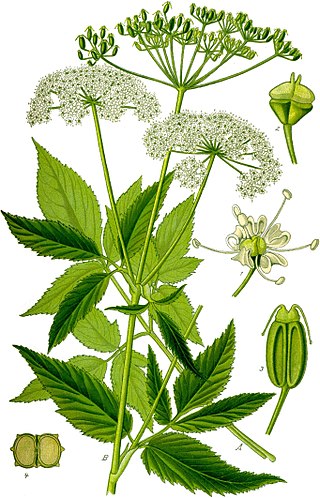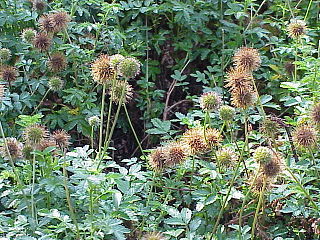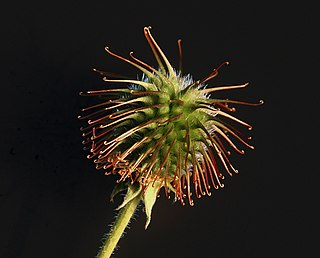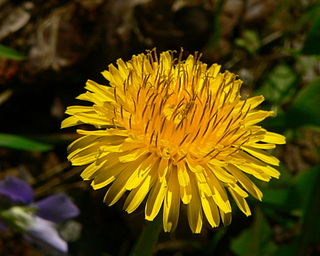Related Research Articles

Banksia is a genus of around 170 species of flowering plants in the family Proteaceae. These Australian wildflowers and popular garden plants are easily recognised by their characteristic flower spikes, and woody fruiting "cones" and heads. Banksias range in size from prostrate woody shrubs to trees up to 30 metres (100 ft) tall. They are found in a wide variety of landscapes: sclerophyll forest, (occasionally) rainforest, shrubland, and some more arid landscapes, though not in Australia's deserts.

In botany, a drupe is an indehiscent type of fruit in which an outer fleshy part surrounds a single shell of hardened endocarp with a seed (kernel) inside. These fruits usually develop from a single carpel, and mostly from flowers with superior ovaries.

Persicaria perfoliata is a species of flowering plant in the buckwheat family. Common names include mile-a-minute, devil's tail, giant climbing tearthumb, and Asiatic tearthumb. It is a trailing herbaceous annual vine with barbed stems and triangular leaves. It is native to most of temperate and tropical eastern Asia, occurring from eastern Russia and Japan in the north, and the range extending to the Philippines and India in the south.

Aegopodium podagraria, commonly called ground elder, is a species of flowering plant in the carrot family Apiaceae that grows in shady places. The name "ground elder" comes from the superficial similarity of its leaves and flowers to those of elder (Sambucus), which is not closely related. Other common names include herb gerard, bishop's weed, goutweed, gout wort, snow-in-the-mountain, English masterwort and wild masterwort. It is the type species of the genus Aegopodium. It is native to Europe and Asia, but has been introduced around the world as an ornamental plant, where it occasionally poses an ecological threat as an invasive exotic plant.

Cirsium vulgare, the spear thistle, bull thistle, or common thistle, is a species of the Asteraceae genus Cirsium, native throughout most of Europe, Western Asia, and northwestern Africa. It is also naturalised in North America, Africa, and Australia and is an invasive weed in several regions. It is the national flower of Scotland.

Heracleum mantegazzianum, commonly known as giant hogweed, is a monocarpic perennial herbaceous plant in the carrot family Apiaceae. H. mantegazzianum is also known as cartwheel-flower, giant cow parsley, giant cow parsnip, or hogsbane. In New Zealand, it is also sometimes called wild parsnip or wild rhubarb.

Lotus corniculatus is a flowering plant in the pea family Fabaceae, native to grasslands in temperate Eurasia and North Africa. Common names include common bird's-foot trefoil, eggs and bacon, birdsfoot deervetch, and just bird's-foot trefoil, though the latter name is often also applied to other members of the genus.

Verbascum thapsus, the great mullein, greater mullein or common mullein, is a species of mullein native to Europe, northern Africa, and Asia, and introduced in the Americas and Australia.

Capsella bursa-pastoris, known as shepherd's purse because of its triangular flat fruits, which are purse-like, is a small annual and ruderal flowering plant in the mustard family (Brassicaceae). It is native to eastern Europe and Asia minor, but is naturalized and considered a common weed in many parts of the world, especially in colder climates, including the British Isles, where it is regarded as an archaeophyte, North America and China, but also in the Mediterranean and North Africa. C. bursa-pastoris is the second-most prolific wild plant in the world, and is common on cultivated ground and waysides and meadows.

Acaena is a genus of about 60 species of mainly evergreen, creeping herbaceous perennial plants and subshrubs in the family Rosaceae, native mainly to the Southern Hemisphere, notably New Zealand, Australia and South America, but with a few species extending into the Northern Hemisphere, north to Hawaii and California.

A tumbleweed is a structural part of the above-ground anatomy of a number of species of plants. It is a diaspore that, once mature and dry, detaches from its root or stem and rolls due to the force of the wind. In most such species, the tumbleweed is in effect the entire plant apart from the root system, but in other plants, a hollow fruit or inflorescence might detach instead. Xerophyte tumbleweed species occur most commonly in steppe and arid ecosystems, where frequent wind and the open environment permit rolling without prohibitive obstruction.

Acacia saligna, commonly known by various names including coojong, golden wreath wattle, orange wattle, blue-leafed wattle, Western Australian golden wattle, and, in Africa, Port Jackson willow, is a small tree in the family Fabaceae. Native to Australia, it is widely distributed throughout the south west corner of Western Australia, extending north as far as the Murchison River, and east to Israelite Bay. The Noongar peoples know the tree as Cujong.

A bur is a seed or dry fruit or infructescence that has hooks or teeth. The main function of the bur is to spread the seeds of the bur plant, often through epizoochory. The hooks of the bur are used to latch onto fur or fabric, enabling the bur – which contain seeds – to be transported to another location for dispersal. Another use for the spines and hooks are physical protection against herbivores. Their ability to stick to animals and fabrics has shaped their reputation as bothersome.

Acacia mearnsii, commonly known as black wattle, late black wattle or green wattle, is a species of flowering plant in the family Fabaceae and is endemic to south-eastern Australia. It is usually an erect tree with smooth bark, bipinnate leaves and spherical heads of fragrant pale yellow or cream-coloured flowers followed by black to reddish brown pods. In some other parts of the world, it is regarded as an invasive species.

Medicago littoralis is an annual plant species of the genus Medicago. Its native range encompasses the Mediterranean Basin, from Macaronesia to the Caucasus; it has been introduced elsewhere. It is useful as a forage for livestock. As a leguminous plant, it is capable of adding nitrogen to soils, through its symbiotic relationship with the bacterium Sinorhizobium meliloti, which enables nitrogen fixation. Common names include shore medick, water medick, coastal medick, and strand medick.
This glossary of botanical terms is a list of definitions of terms and concepts relevant to botany and plants in general. Terms of plant morphology are included here as well as at the more specific Glossary of plant morphology and Glossary of leaf morphology. For other related terms, see Glossary of phytopathology, Glossary of lichen terms, and List of Latin and Greek words commonly used in systematic names.

Taraxacum is a large genus of flowering plants in the family Asteraceae, which consists of species commonly known as dandelions. The scientific and hobby study of the genus is known as taraxacology. The genus is native to Eurasia but the two most commonplace species worldwide, T. officinale and T. erythrospermum, were introduced from Europe into North America, where they are invasive aliens. Dandelions thrive in temperate regions and can be found in yards, gardens, sides of roads, among crops, and in many other habitats. Both species are edible in their entirety and have a long history of consumption. The common name dandelion is also given to specific members of the genus.

Linaria dalmatica is a herbaceous, short-lived perennial plant native to western Asia and southeastern Europe that has become a weed in other areas. The family this plant now belongs to is the Plantaginaceae Family. Previously, it belonged to the Scrophulariaceae (Figwort) family. Its common names include Balkan toadflax, broadleaf toadflax, and Dalmatian toadflax. Linaria dalmatica has unique yellow flowers with an orange center that draw individuals to purchase them to display in their gardens. The distribution of L. dalmatica to North America can be attributed to use as a fabric dye, folk remedies and as an ornamental plant. However, it is now classified as a weed in both Canada and the U.S.A.

An escaped plant is a cultivated plant that has escaped from agriculture, forestry or garden cultivation and has become naturalized in the wild. Usually not native to an area, escaped plants may become invasive. Therefore, escaped plants are the subject of research in invasion biology.

Adventive plants or adventitious plants are plants that have established themselves in a place that does not correspond to their area of origin due to anthropogenic influence and, therefore, are all wild species that have only been established with the help of humans, in contrast to the native species.
References
- ↑ SHIMWELL, D. W. "A Shoddy Tale: perspectives on the wool alien flora of West Yorkshire in the twenty-first century" (PDF). Retrieved 19 June 2013.
- ↑ Stace, Clive (1997). New Flora of the British Isles (2nd ed.). Cambridge University Press. p. 484. ISBN 978-0-521-58935-2.